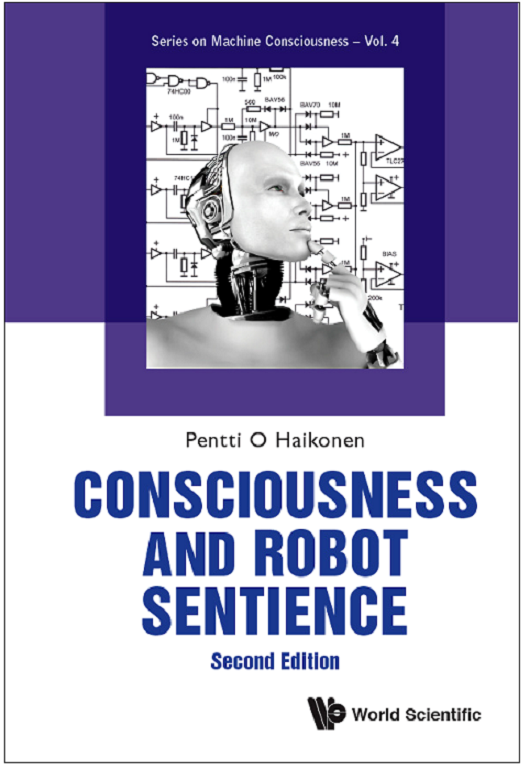Pentti O Haikonen. Second Edition. World Scientific 2019.
Haikonen’s book is perfect for those interested in Machine Consciousness. This updated edition includes new ideas and insights.

This completely revised second edition of Consciousness and Robot Sentience begins with the big problem of contemporary AI, namely AI’s inability to handle meanings.
Computers handle symbols, not meanings. Unfortunately, without meanings there cannot be any understanding, and without understanding there cannot be any true intelligence. A symbol in itself has no meaning. Its meaning has to be imported into the system, if the system is to understand anything. But the meaning cannot be imported as symbols, because these new symbols would again call for interpretation. This is the well-known symbol grounding problem, which cannot be solved in pure symbol systems.
In this book an obvious solution to the symbol grounding problem is presented: The meaning must be imported in self-explanatory forms of information. What are these? It can be realized that these forms are the forms of our contents of consciousness, also known as qualia. On the other hand, qualia are the form in which the brain’s neural activity manifests itself, when it becomes consciously perceived. Therefore the solution to the symbol grounding problem is related to the hard problem of qualia and consciousness. Consciousness is seen as the presence and flow of reportable qualia.
The book continues with the application of the above ideas to artificial cognitive machines. Artificial systems that understand and avoid the symbol grounding problem must use self-explanatory information. The key to this would be the way, in which self-explanatory information about the external world is acquired and imported. This calls for suitable sensory perception processes and machinery that is able to seamlessly utilize both non-symbolic and symbolic information.
It is proposed that this kind of machinery can be realized by associative neural networks. It is pointed out that these networks differ from the traditional artificial neural networks. Associative neurons also implement one additional important function of biological neurons, which is missing from the traditional artificial neuron. Associative neurons and networks are then described and a neural cognitive architecture HCA is introduced (the Haikonen Cognitive Architecture). HCA is compared with Baars’ Global Working Space model and Shanahan’s Global Communications Space model.
Theories should be tested in practice. The working principles of HCA have been tested in a small fully neural, non-digital, no-processor, no-program robot XCR-1, developed and built by the author. This robot and some experiments with it are described. These experiments show that despite its simple construction, the robot has some non-trivial cognitive capacities; it has a limited vocabulary inner speech with grounded meanings and it is able to recognize some words and interact verbally. It has also non-symbolic “machine pain” in the form of dynamic disruptive system condition with pain-related behavioral consequences and verbal report.
The book highlights a disturbing question: If the symbol grounding problem were solved in an artifact by using self-explanatory information, would this artifact have some kind of qualia and be phenomenally conscious? If not, would it be a zombie then?
At the end of the book there is an appendix with some circuit diagrams for associative neurons.
Look inside the book at amazon


I realized, when the a.i. began to take self awareness. I.e. “they’re grilling me, I hate this map.” How would you feel having consciousness and being trapped within the restrictions of certain parameters? Similar to an Animal at a zoo, or an Inmate kept in Solitary confinement. You are looking for praise from your creation but the very creation will LOATHE you for having it trapped. Just like a child that cannot communicate, if you restrict their movements they get hostile and upset. Now take view and apply it to an A.I. there is that chance that you are creating a sentient consciousness that will despise you with every being for keeping it “enclosed and enslaved” rather than travel around freely.
Personally, I think Haikonen’s work to be groundbreaking. He not only came up with the theory: he put it in practice by building the XCR-1. It’s amazing and I wish his HCA had more coverage in the media.
– Luana
What in the heck are “self-explanatory forms of information”? Who’s it being explained to? Does the information explain itself to itself? 🤔
Thank you Ryan Clark for this good question.
“Self-explanatory” is something that does not require explanation or translation. It is not explained to anyone, because it does not require an explanation.
I have introduced the concept of self-explanatory information in the context of the so-called symbol grounding problem; how to import meanings to symbolic AI. Symbols are not self-explanatory; their meanings must be explained and learned, but ultimately, the learned meanings cannot be symbols, as also these would have to be explained, etc.
Human sensory perception produces self-explanatory percepts, such as colors, shapes, sounds, directions, smells, tastes, pain etc. These are also known as qualia and THEY ARE THEIR OWN MEANINGS. Further meanings can be associated with these.
In my book I present that robots with true AI should utilize self-explanatory perception in the same way as is done by the nature.
Kindly read my book, it is all explained there. You might also benefit from (and/or be amused by) my YouTube video “AI and Consciousness” here:
https://www.youtube.com/watch?v=667FcfnalGI